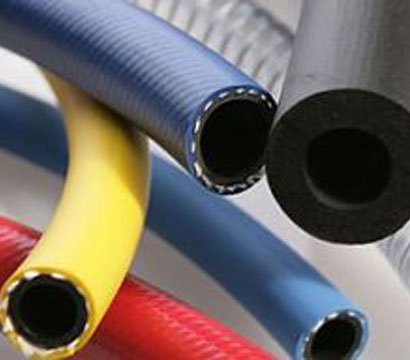Hose & Fittings

Hoses are used for transferring many different types of dry bulk materials (sand, gravel, asphalt, wood chops, grain, rock, flour, etc.) and fluids (water, waste, mine slurry, chemicals, oils, fuel, food, hot tar, steam, etc.) and are either used in suction or discharge applications.
These hoses can be EPDM rubber, nitrile, PVC, Polyethylene and could have wire or synthetic yarn reinforcement, steel or plastic helix so they resist collapsing under suction and various PSI rating and negative pressure ratings.
Hose is also used in air application to operate tools in construction, mining and drilling to name a few and could also be reinforced with wire or synthetic yarns.
For each application, different hoses may be needed so it is important to know a minimum amount of information before ordering hose. The industry uses the acronym "S.T.A.M.P.E.D." in order to start the process of selecting the proper hose for your application. "S" is for Size, "T" for the temperature, "A" for application, "M" for media going through the hose, "P" for the operating pressure (PSI), "E" for end fittings and "D" for delivery of the hose assembly.
It is also extremely important to know if the hose you are using needs to be grounded to prevent static electricity. Some materials moving through the hose can create a build-up of static electricity which could spark and ignite resulting in serious damages and personal injuries.
When considering end fittings, there are again a multitude of different fittings with different working pressures and applications, so the more you know about your application the easier the proper selection will be. Fittings can be made of aluminum, steel, plastics and other specialty metals and can be swiveling, fixed and lockable. Properly attaching end fittings to the hose is extremely important as you need to respect and maintain the rating you require. The hose and fittings may have the appropriate ratings you require, but if the means of securing them together into an assembly is not done properly, a failure may occur resulting in equipment or environmental damages and/or personal injury. We rely heavily on our suppliers for their expertise to ensure the correct and proper products are delivered to our customers for their applications.
